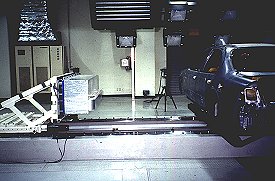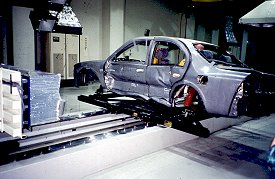 The Side Dynamic Emulation Procedure ( SIDE) is a developed and proven system supplied by HYGETM. This is accomplished by two sleds the vehicle sled (Black) and the impact sled (White). The vehicle sled is positioned at a determined location and the impact sled with a deformable element attached is accelerated by the HYGETM. It strikes the vehicle on the second sled.
The Side Dynamic Emulation Procedure ( SIDE) is a developed and proven system supplied by HYGETM. This is accomplished by two sleds the vehicle sled (Black) and the impact sled (White). The vehicle sled is positioned at a determined location and the impact sled with a deformable element attached is accelerated by the HYGETM. It strikes the vehicle on the second sled.
Units are operated internationally.
Function
- Emulates full-scale crash to Federal and European regulations.
- Utilizes the HYGETM reverse acceleration system
- Allows side impact development to be performed using body shell, stick side trim and restraint system components.
- Cost effective tool for the development and investigation of vehicle body shell construction.
Components
- Two braked sleds with ballast weights and control console
- Both sleds operate on standard HYGETM standard rail system
- The struck sled carries the vehicle body shell and is ballasted to correct vehicle weight.
- The vehicle sled brake can be adjusted to simulate the restraining forces between tire and road.
- The striking sled is equivalent to the full scale barrier and maybe configured to Federal or European standards.
- The striking sled carrier has the specified deformable barrier element.
- The ballast allows the weight of both the struck and striking sled to be set to applicable test requirements.
- The control console is used for setting the various brake pressures and integrating system into existing interlock system.
 Operation
Operation
- The struck sled is positioned at prescribed location on rails in front of the deformable barrier element of the striking sled.
- The striking sled is positioned against HYGETM piston
- The HYGETM is used to accelerate the striking sled to required velocity.
After the test the sleds are both stopped using onboard braking systems.
Benefits
- Provides cost effective alternative to full scale side crash testing by using HYGE test facility and eliminating the need for fully-built test vehicles.
- Provides repeatable test conditions.
- Correlation with the crash test
Training and Commissioning
Training, installation and commissioning of the equipment are available.


